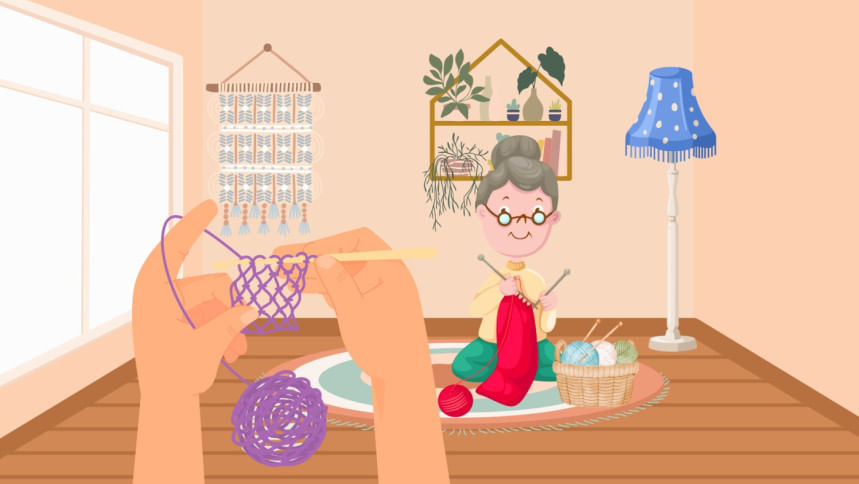From my grandmother’s hands to mine: The timeless appeal of crochet

My grandmother's hands are very soft and etched with lines, each telling a story. Growing up, I watched these same hands make so many things for me, whether it was something as simple as knitted clothes or doll houses from scratch.
But my favourite was when she made me small plushies out of soft yarn—her own creations, the result of hours of crocheting.
"Crocheting was known as kushi kata in our area. It takes up a lot of time because you have to individually loop each stitch with care," she said, her fingers already moving in rhythm as if muscle memory had never left. "The tension between the loops has to be consistent. Otherwise, some might be too loose or too tight."
She went on to explain how, back in the 80s and 70s, crocheting was more than a hobby for women; it was almost a rite of passage. In rural homes and neighbourhoods alike, blankets, table runners, lacy caps, and, sometimes, even curtains came to life under their hands. Back then, it was common for all houses to have a front lawn, and for children and teenagers to play in it during the evening after studies. Neighbours would often sit down together on the lawn, share cups of tea, and chat while crocheting together.
Yarn wasn't always available. My grandmother and her sisters would unravel old sweaters or use thick cotton threads dyed with tea or turmeric to get the right shade. They relied on observation and memory. "At one point, you just know how to get it right, and it was very common to have crocheted table runners or coasters in a house. It was also more of a common summer activity, as it gave us time to crochet things for winter," she said.
As she taught me how to hold the hook and loop, I noticed how crocheting with her made me feel connected to a part of my heritage I didn't know I had been missing. With each row, I imagined not just stitches, but of neighbours who crocheted pillowcases for their daughters' weddings or of winters when everyone in the family wore something they had made with their own hands.
What amazes me is that crocheting never disappeared with the old traditions; it simply evolved. Today, it has made a full comeback. A quick scroll through social media shows countless people selling handmade crochet bags, tiny dolls, keychains, and trendy crop tops. Online shops are filled with crochet accessories, while YouTube tutorials and Pinterest boards offer endless ideas to learn from and recreate.
As much as crochet has found its place in the e-commerce world, it isn't always financially sustainable for the makers. A single piece, whether a plushie or a crop top, can take hours to complete and require several balls of yarn. Pricing it to reflect the time and materials often pushes it beyond what the average buyer is willing to pay. This leaves makers in a difficult position: either undervalue their work or set a price so high that it likely won't sell.
Yet, for many, crochet remains more a labour of love than a profitable venture.
Modern crochet is stylish, global, and proudly handmade. No longer tied to living rooms or grandmotherly stereotypes, it has found new life among young people who crochet on campuses, in cafés, and even during commutes. The internet has transformed crochet into both an aesthetic and a coping mechanism. Perhaps that's part of why it has made such a strong comeback.
In a world dominated by mass production, crocheted pieces carry a distinctly human touch. People are drawn not only to their beauty but also to their imperfect, textured, handmade quality, something that stands apart from the uniformity of fast fashion.
And speaking of coping, crocheting is incredibly therapeutic, something I realised as my grandmother taught me how to get into a rhythm. There's something about the repetition of stitching, the feel of yarn between your fingers, and the gentle focus it demands that calms a restless mind. Psychologists even recommend it for anxiety and stress relief. In a way, crocheting invites slowness. It teaches patience, just like my grandmother always said it would.
So here I am, decades apart from my grandmother's youth and miles away from the village homes she once described, yet I understand crocheting more deeply than I ever did before. What began as a simple pastime has become my connection to her stories, and it makes me glad to see how crocheting has grown ever more popular with our generation.
Even if it may not always pay the bills, crocheting pays in presence and in the joy of creating something with our own hands, just like our grandmothers did, and now, so do we.
Tinath Zaeba is an optimistic daydreamer, a cat mom of 5 and a student of Economics at North South University. Get in touch via [email protected].

 For all latest news, follow The Daily Star's Google News channel.
For all latest news, follow The Daily Star's Google News channel. 








Comments